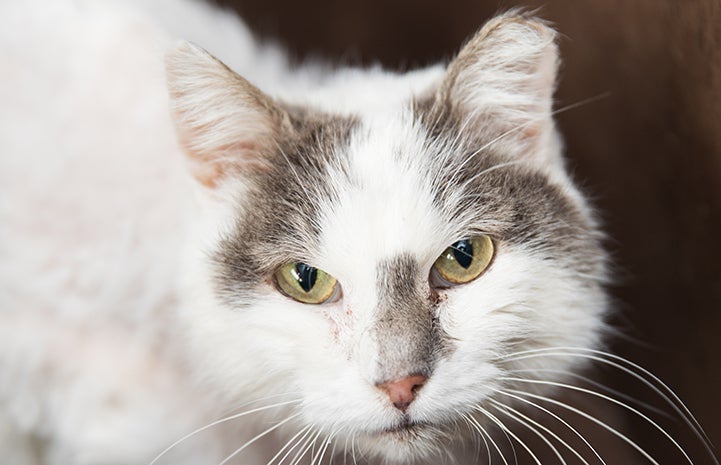
Cat Hyperthyroidism: Symptoms and Treatments
Hyperthyroidism in cats happens when the thyroid gland produces excess thyroid hormone as a result of abnormal functioning. Typically affecting older cats, cat hyperthyroidism is the most common endocrine disease we see in the species. It affects both males and females equally, and any breed can develop the disorder — with Siamese cats showing somewhat increased incidence compared to other breeds.
Learn more about the symptoms of hyperthyroidism in cats plus potential treatments.
What are the symptoms of hyperthyroidism in cats?
In most instances, the cat's thyroid abnormality is caused by hyperplasia, which is an overgrowth of thyroid tissue. The thyroid produces an excess of a hormone called thyroxin. Thyroxin is broken down into a form used by the body to help in such functions as regulating body heat production and metabolizing fats, proteins, and carbohydrates.
When too much thyroxin is produced, over time we can see issues including seemingly uncontrollable thirst and hunger, excessive urination, and weight loss despite consumption of large amounts of food. Other potential symptoms of cat hyperthyroidism include poor fur quality, vomiting, diarrhea, weakness, and hyperactivity often characterized by the cat being unable to settle down and becoming very vocal.
Hyperthyroidism in cats can also lead to symptoms that aren’t outwardly visible but that can result in very serious health problems — for example, cardiomyopathy, a form of heart disease in which the heart muscles become thickened. This thickening causes a decrease in the size of the heart chambers, and the heart has to work harder to pump the necessary amount of blood to the body. The increased heart activity then leads to hypertension (high blood pressure) that, if left unchecked, can result in retinal bleeding or detached retinas, which can lead to sudden blindness in your cat.


See how your community is doing
Treatments for cat hyperthyroidism
Fortunately, cat hyperthyroidism is a treatable disease, and once the hormone level is stabilized, the issues caused by the overactive thyroid can be reversed.
The most common treatment is through the daily use of an anti-thyroid medication called methimazole. It can be given in the form of a pill, compounded into a liquid or applied transdermally via a gel that’s placed on the cat’s ear. It is critical for your cat to receive the correct daily amount of methimazole, so your veterinarian will work with you once the diagnosis is made to carefully monitor dosages and blood work to determine the optimal dose for your cat.
There are other treatment options as well. One is I-131 radiation therapy, in which radioactive iodine is used to destroy thyroid tissue without affecting surrounding tissues. This non-invasive treatment is usually performed at a specialty clinic, and once it is completed there is no need for medications to control the hyperthyroidism. Another option is surgically removing the affected thyroid tissue. As with radiation therapy, once this is done, daily thyroid medication is not needed. If you are interested in either of these procedures, your veterinarian can give you the names of clinics in your area that provide such services.
Finally, the use of a special iodine-restricted diet can be effective in some situations. It is thought that excessive levels of iodine in cat foods might contribute to the development of hyperthyroidism, so feeding a food that has low levels of iodine can often lead to the normalizing of thyroid function without the need for giving daily medication.
This option might seem like the simplest solution, but feeding an iodine-restricted diet can often be quite challenging. Your cat must eat the special diet, and nothing else, for the rest of their life. That means you cannot give the cat treats, and if you have a multiple-cat household you cannot allow your affected cat access to any of the other cats’ food.
With any of these treatment options, regular monitoring via blood work is necessary to help ensure that thyroid levels remain in the normal range.
Choosing a treatment for feline thyroid disease
When choosing a treatment for hyperthyroidism in cats, you’ll want to consider cost, convenience, and the disposition of your cat.
Daily use of methimazole is the most cost-effective treatment, but if you have trouble giving medications to your cat, you might need to use another option. Although surgery and I-131 radiation therapy have high initial costs, once done you only have to do regular blood work monitoring. And an iodine-restricted diet can be a good noninvasive solution if you can ensure that your cat will be eating only the special food.
Once effective treatment is achieved and maintained, the clinical signs typically reverse, and your cat can live out life normally. Without treatment, the clinical signs and health issues will likely continue to advance, resulting in progressively worsening quality of life. So once a diagnosis of hyperthyroidism has been made, it is in your and your cat’s best interest to treat the disease. Work hand in hand with your veterinarian to come up with the best solution for your situation.
